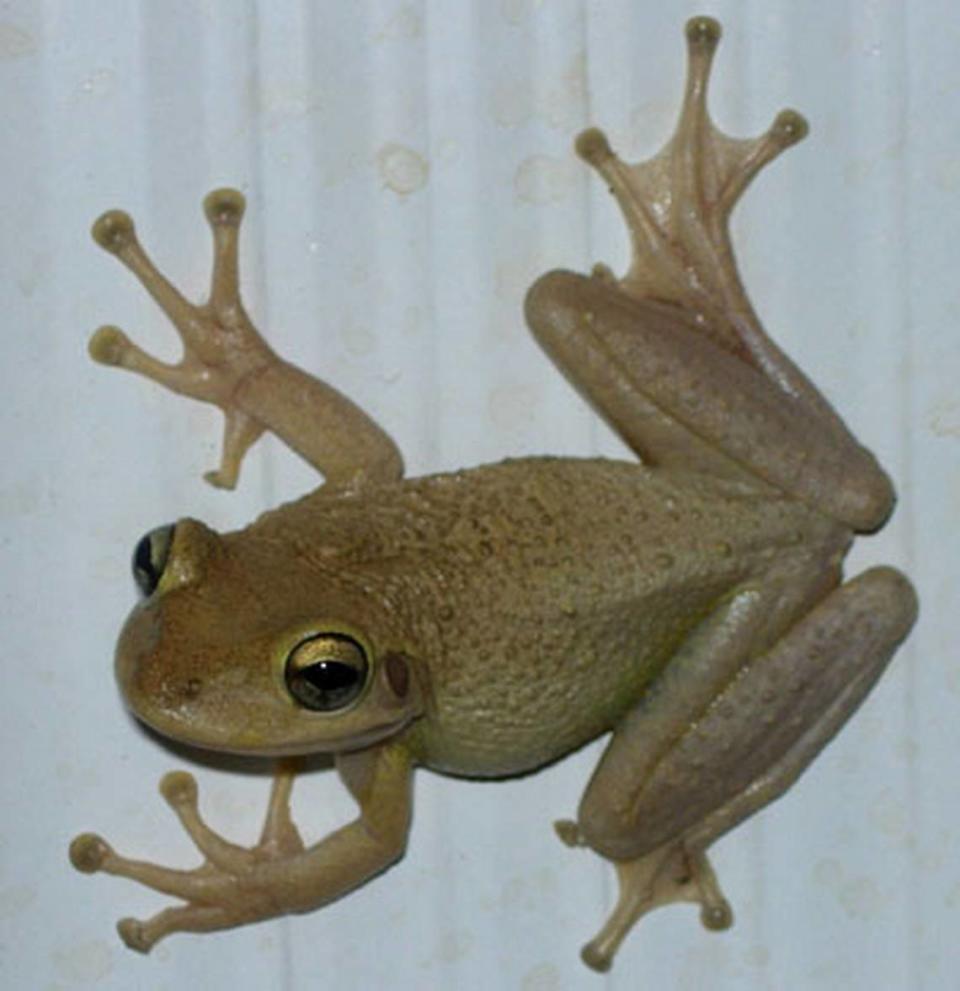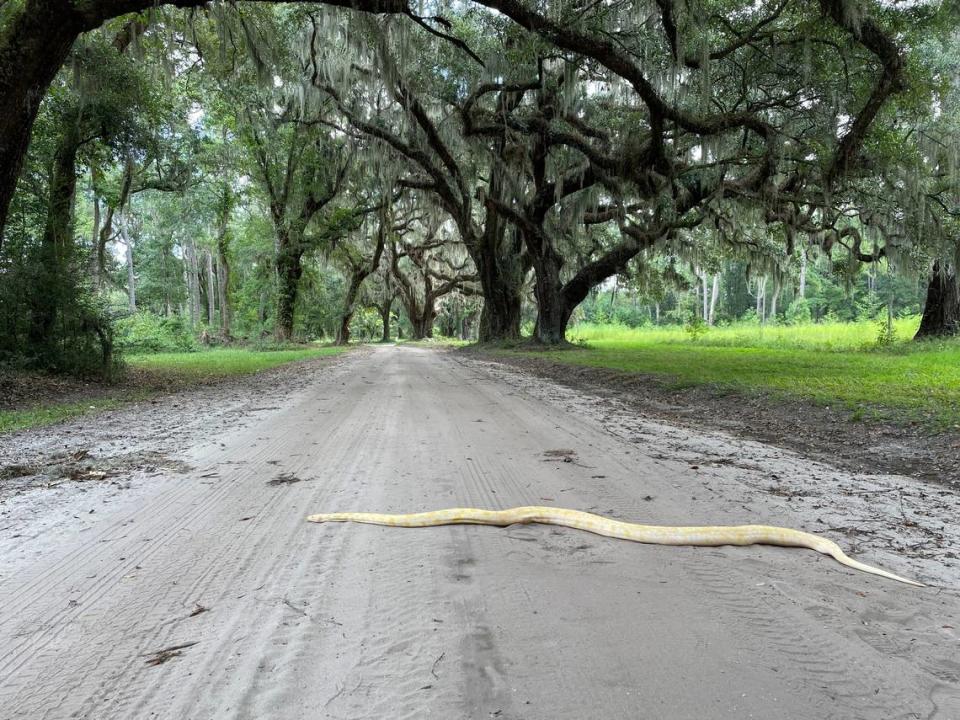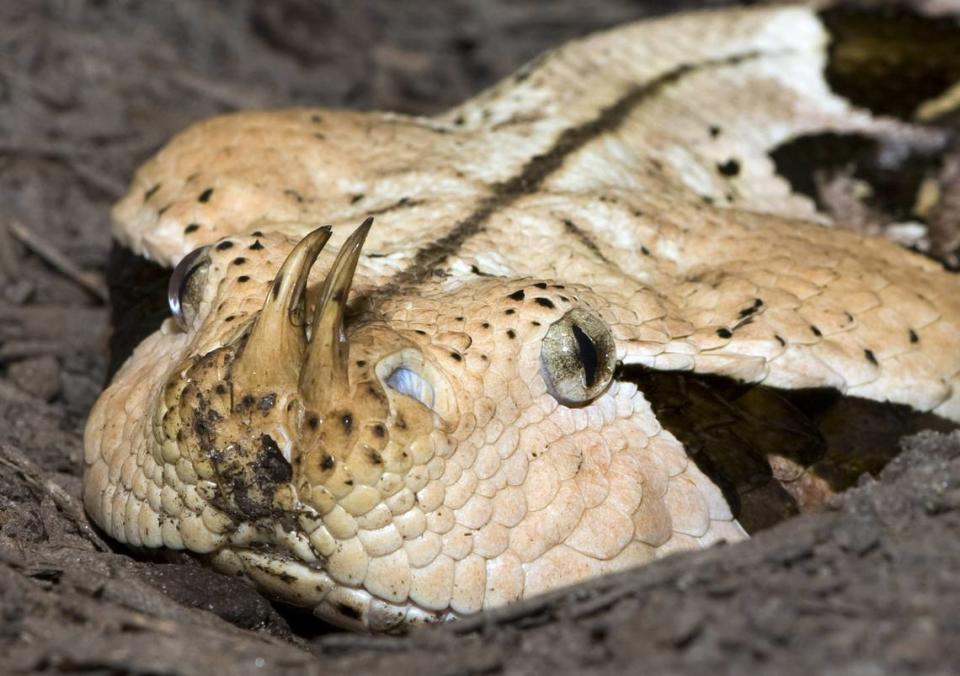Exotic reptiles are escaping across South Carolina. Wildlife officials worry about threats
In less than a decade, state wildlife officials have received nearly 250 reports of nonnative reptiles and amphibians escaping or being released in South Carolina, where the slithering animals are popular with pet owners.
The S.C. Department of Natural Resources says at least 30 species have gotten loose since 2013, including large snakes, monitor lizards, turtles, iguanas and Cuban tree frogs, all of them raising concerns about the impact they are having on native wildlife.
The DNR, in a Facebook post this week, included a picture of a long, yellowish snake taking up nearly the entire width of a dirt road.
The snake has been identified as a type of Burmese python, said Will Dillman, the DNR’s assistant chief of wildlife. Landowners on Johns Island near Charleston encountered the animal and contacted the DNR about it, Dillman said.
Burmese pythons, which are from southeast Asia, are among the largest snakes in the world, growing to as much as 23 feet long, according to National Geographic. The big predators are not venomous but have sharp teeth. They can be a range of colors.
Anyone who has acquired a nonnative reptile or amphibian needs to know that it is illegal to release them to the wild, the DNR says. Dillman said many of the reports the agency has gotten are about animals that have been released or escaped.
“Always do your research before purchasing a pet to learn about the requirements of the specific species,’’ the DNR said in its Facebook post.
In addition to traditional pets like cats and dogs, snakes and turtles have become popular through the years as pets. Thousands of people attend reptile shows each year in South Carolina to purchase the animals as pets.
A key worry about exotic species is that they could adapt to South Carolina and begin reproducing. That isn’t as big a threat as in Florida, where milder winter temperatures make it easy for many tropical species to survive, but South Carolina has its own share of animals that could reproduce.
In recent years, the agency has been particularly concerned about black and white tegus, powerful lizards that are native to South America. The Facebook post included a picture of a tegu underneath an automobile.
Tegu lizards, which can grow longer than 4 feet and weigh up to 10 pounds, have been found in “numerous” South Carolina counties in recent years, according to the DNR.
“They seem to be pretty cold-hardy, especially in the lower portions of the state,’’ Dillman said. “So there is some potential for them to be able to overwinter and reproduce.’’
Georgia, he said, already has established tegu populations.
Tegu lizards will eat eggs of birds that nest on the ground, such as quail and turkeys, and tortoise and alligator eggs, according to the Georgia Department of Natural Resources, which also has cited concerns about the lizards. They also can carry exotic parasites that could affect native wildlife, Georgia officials report.

Rising reports
According to S.C. DNR statistics released this week, the agency has received a sharp overall increase in exotic reptile and amphibian reports since 2013. The numbers rose from three reports in 2013 to 90 in 2020.
The numbers dropped from 2020 to this year, but they still are substantially higher than in 2013 and 2014. In 2021, the DNR received 48 reports, according to agency statistics. It has received 38 reports so far in 2022.
All told, more than 50 of the reports were about tegus, DNR data show. Nearly 60 reports were about Mediterranean geckos. An American crocodile was reported in 2020 in Beaufort County, while a Nile crocodile was reported in 2013 in Lexington County, DNR data show.
Part of the reason for the increase in reports may be because the DNR has been encouraging people to tell the wildlife agency about nonnative creatures they see on the landscape, Dillman said.
This week, the state DNR received a report of a cayman being found in the Greenville area of northwestern South Carolina, Dillman said. The alligator-like reptile is native to South America. The size of the cayman was not available, but some caymans can reach 15 feet in length.

Snake handlers
Worries about the release of nonnative reptiles and amphibians aren’t new in South Carolina.
State laws have been riddled with loopholes that allowed people to easily trade snakes, turtles and similar animals on the worldwide black market. That has allowed traders to move more freely in South Carolina than other states.
In one case, a man involved in the black market wildlife trade imported 220 highly venomous snakes from Africa to Atlanta with plans to sell them at a wildlife show in South Carolina, The State reported in 2018. Those snakes included black forest cobras, Gaboon vipers, spitting cobras and bush vipers.
South Carolina also is one of the few places in the country where people have been able to buy venomous snakes at reptile shows. Snake-handling preachers from Appalachia at times visited South Carolina to buy the dangerous serpents for their services.
State officials have attempted to crack down on the illegal reptile trade and have enacted tighter laws in recent years, particularly to protect native turtles. But not all loopholes have been filled. It is still legal, for instance, to buy a venomous snake at a reptile show, according to the DNR.
The DNR encourages people to take pictures of nonnative species they see, record the location and contact the agency to herps@dnr.sc.gov.
To report sightings of black and white tegus, visit https://arcg.is/00LH5z0.


